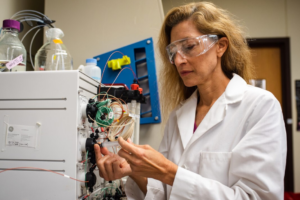AUSTIN, Texas — Inspired by a naturally occurring material found in marine mussels, researchers at The University of Texas at Austin have created a new flame retardant to replace commercial additives that are often toxic and can accumulate over time in the environment and living animals, including humans.
Flame retardants are added to foams found in mattresses, sofas, car upholstery and many other consumer products. Once incorporated into foam, these chemicals can migrate out of the products over time, releasing toxic substances into the air and environment. Throughout the United States, there is pressure on state legislatures to ban flame retardants, especially those containing brominated compounds (BRFs), a mix of human-made chemicals thought to pose a risk to public health.

A team led by Cockrell School of Engineering associate professor Christopher Ellison found that a synthetic coating of polydopamine — derived from the natural compound dopamine — can be used as a highly effective, water-applied flame retardant for polyurethane foam. Dopamine is a chemical compound found in humans and animals that helps in the transmission of signals in the brain and other vital areas. The researchers believe their dopamine-based nanocoating could be used in lieu of conventional flame retardants.
The researchers’ findings were published in the journal Chemistry of Materials on Sept. 9.
“Since polydopamine is natural and already present in animals, this question of toxicity immediately goes away,” Ellison said. “We believe polydopamine could cheaply and easily replace the flame retardants found in many of the products that we use every day, making these products safer for both children and adults.”
Using far less polydopamine by weight than typical of conventional flame retardant additives, the UT Austin team found that the polydopamine coating on foams leads to a 67 percent reduction in peak heat release rate, a measure of fire intensity and imminent danger to building occupants or firefighters. The polydopamine flame retardant’s ability to reduce the fire’s intensity is about 20 percent better than existing flame retardants commonly used today.
Researchers have studied the use of synthetic polydopamaine for a number of health-related applications, including cancer drug delivery and implantable biomedical devices. However, the UT Austin team is thought to be one of the first to pursue the use of polydopamine as a flame retardant. To the research team’s surprise, they did not have to change the structure of the polydopamine from its natural form to use it as a flame retardant. The polydopamine was coated onto the interior and exterior surfaces of the polyurethane foam by simply dipping it into a water solution of dopamine for several days.
Ellison said he and his team were drawn to polydopamine because of its ability to adhere to surfaces as demonstrated by marine mussels who use the compound to stick to virtually any surface, including Teflon, the material used in nonstick cookware. Polydopamine also contains a dihydroxy-ring structure linked with an amine group that can be used to scavenge or remove free radicals. Free radicals are produced during the fire cycle as a polymer degrades, and their removal is critical to stopping the fire from continuing to spread. Polydopamine also produces a protective coating called char, which blocks fire’s access to its fuel source — the polymer. The synergistic combination of both these processes makes polydopamine an attractive and powerful flame retardant.
Ellison and his team are now testing to see whether they can shorten the nanocoating treatment process or develop a more convenient application process.
“We believe this alternative to flame retardants can prove very useful to removing potential hazards from products that children and adults use every day,” Ellison said. “We weren’t expecting to find a flame retardant in nature, but it was a serendipitous discovery.”
Ellison’s research received funding from a 3M Nontenured Faculty Award, DuPont Young Professor Award and the Norman Hackerman Advanced Research Program.



